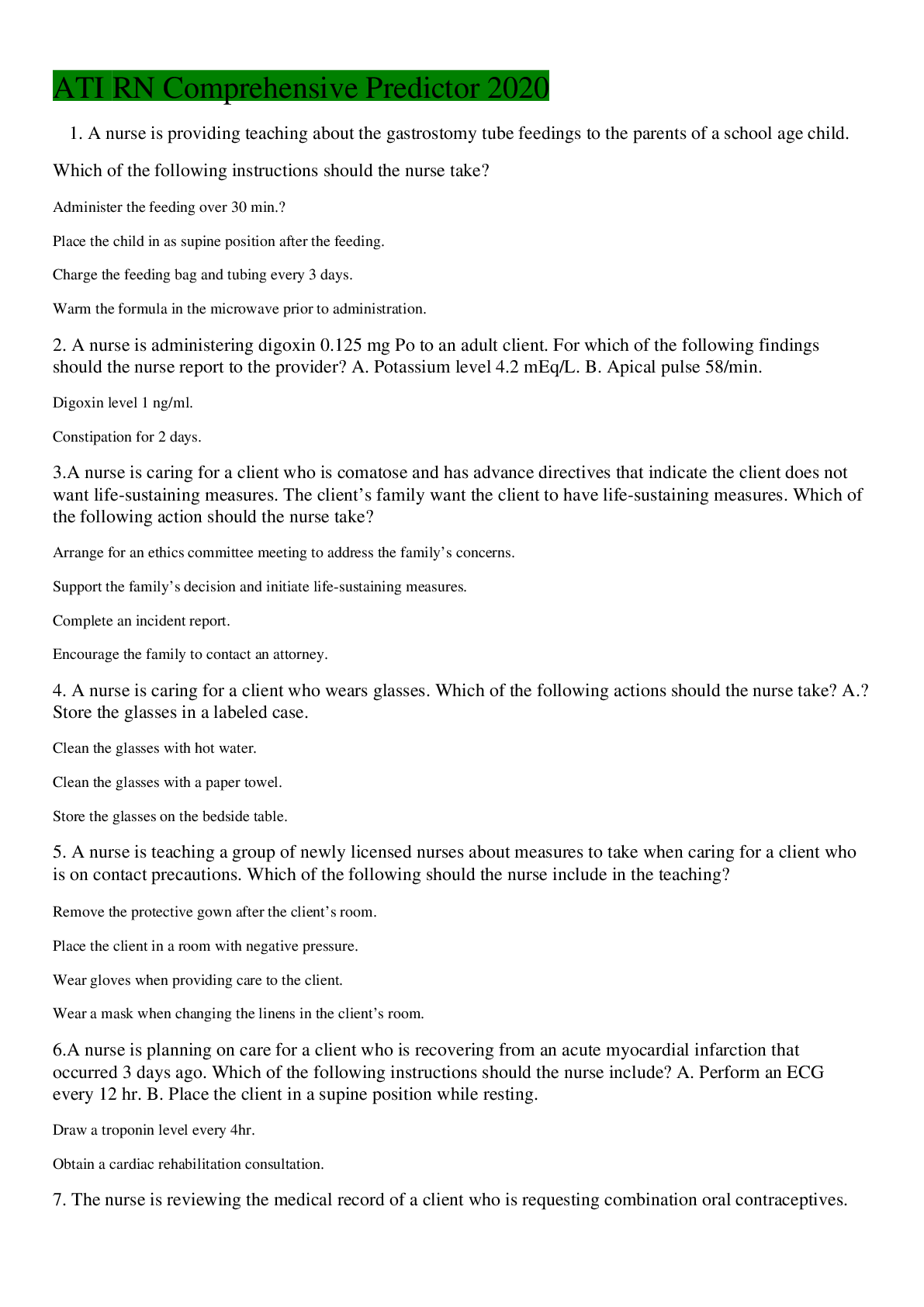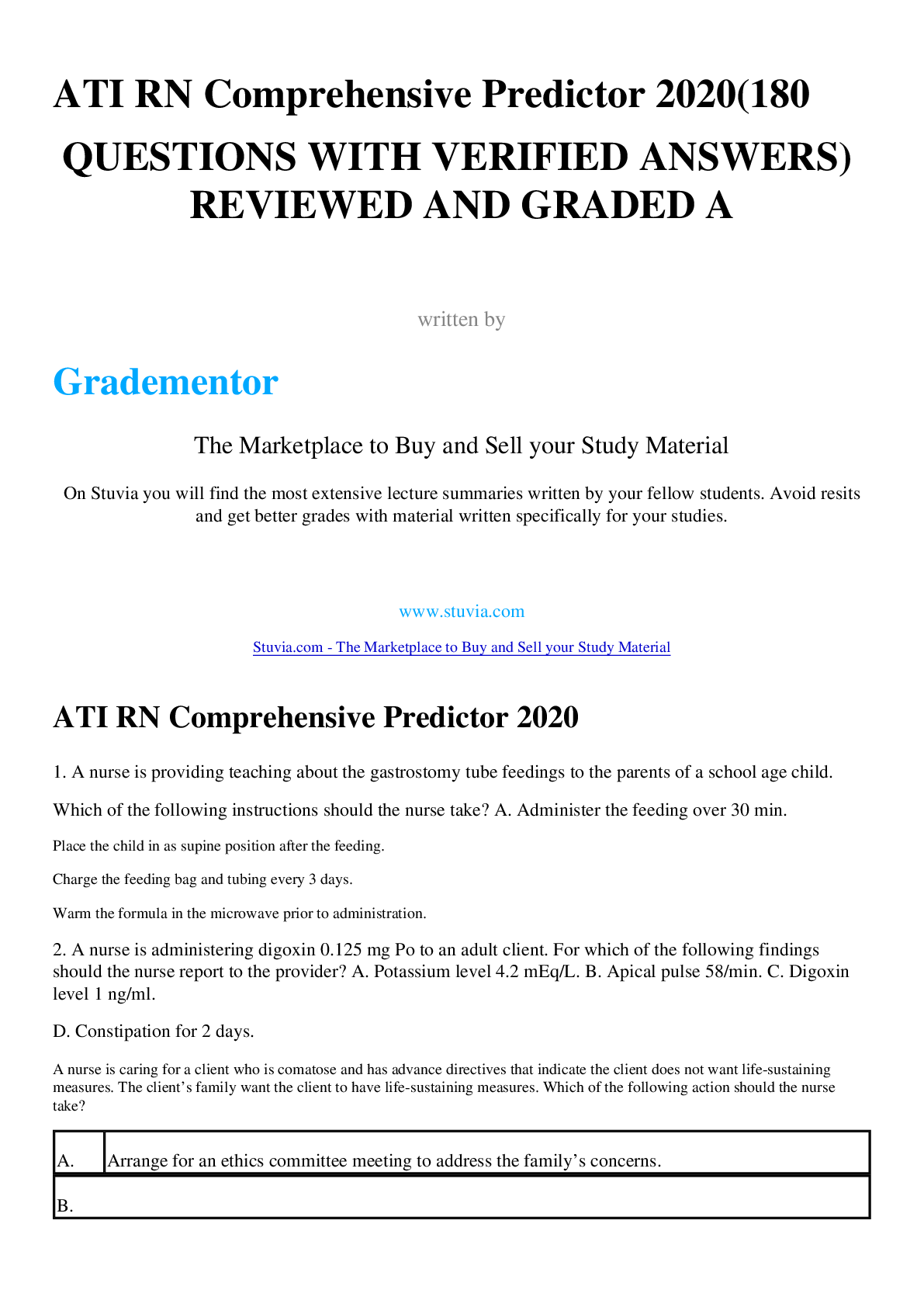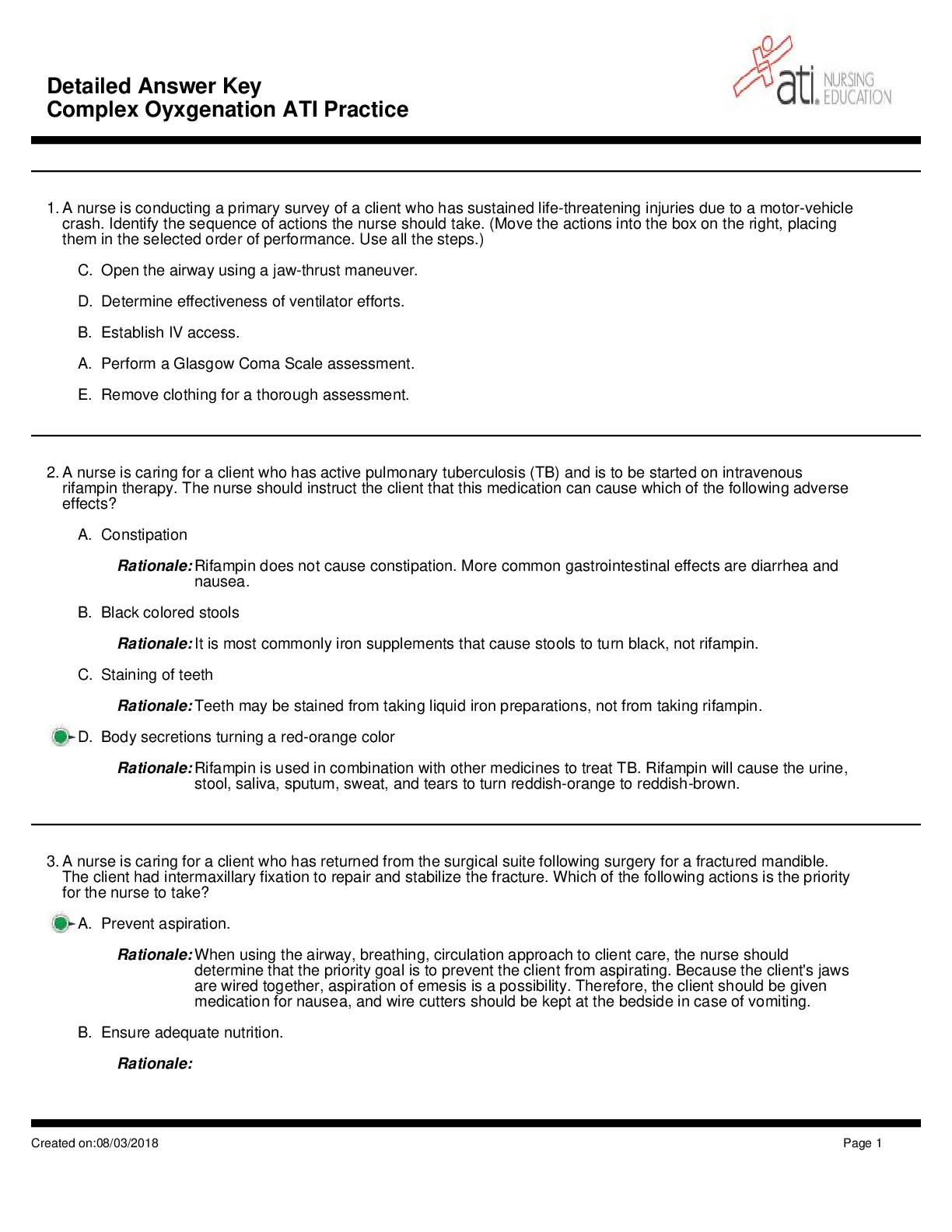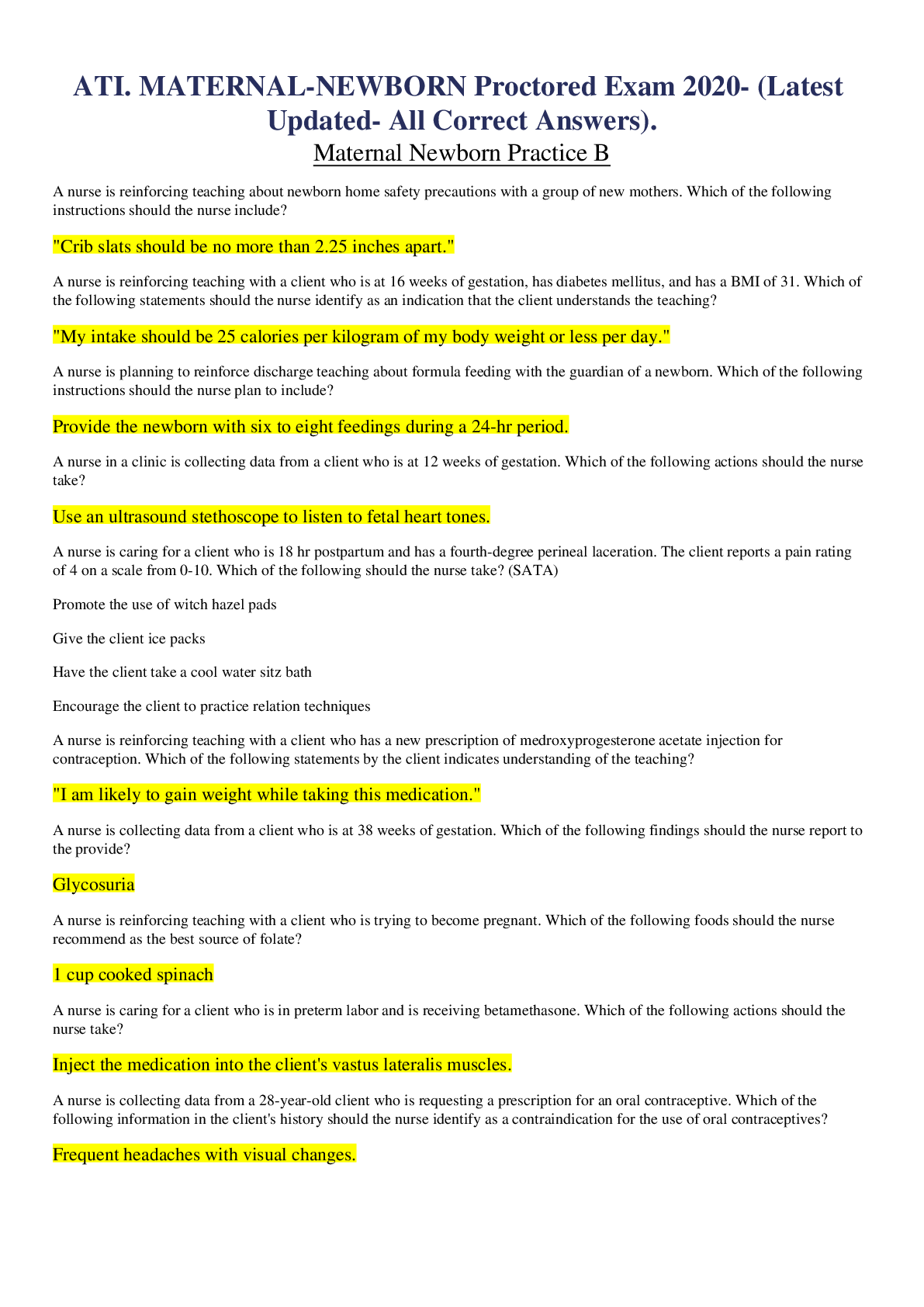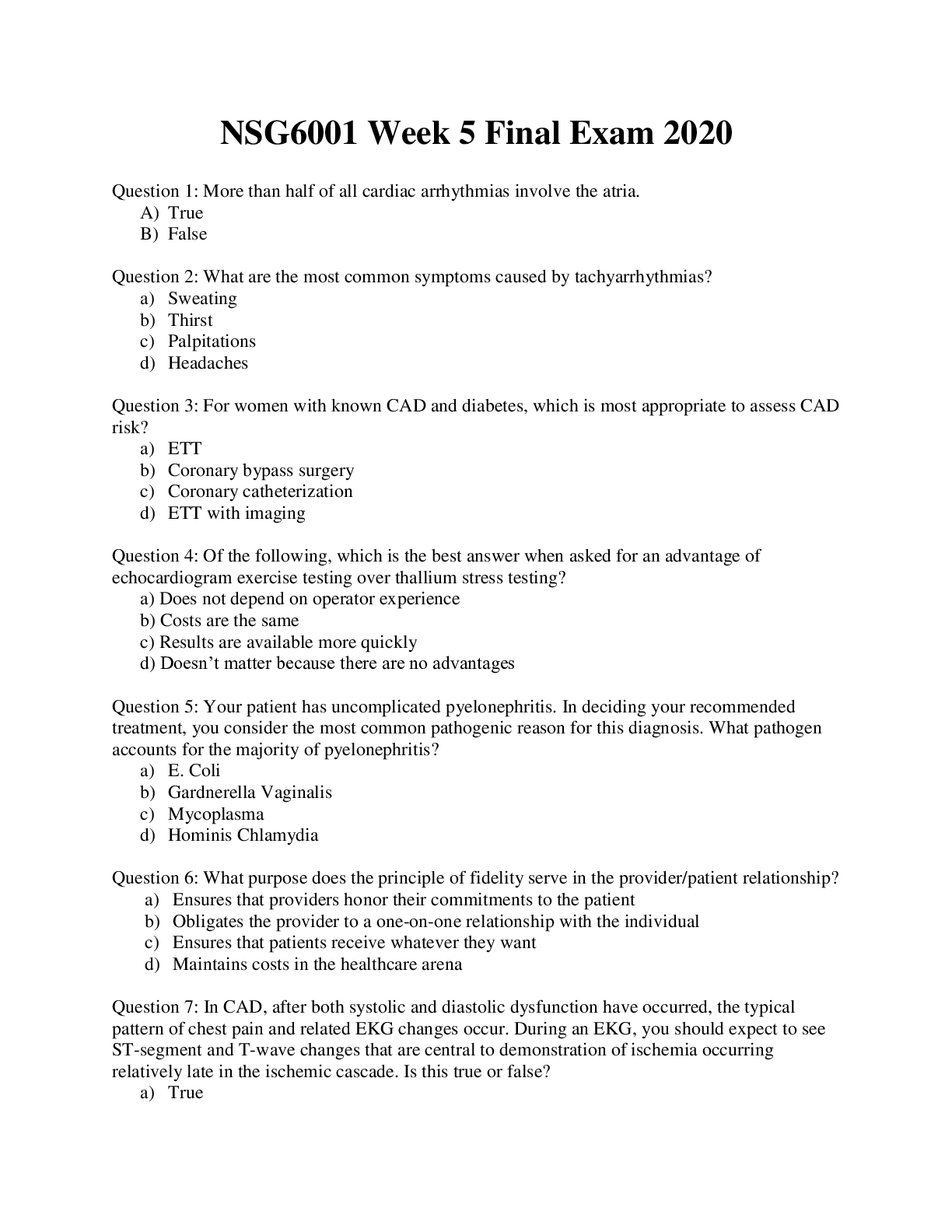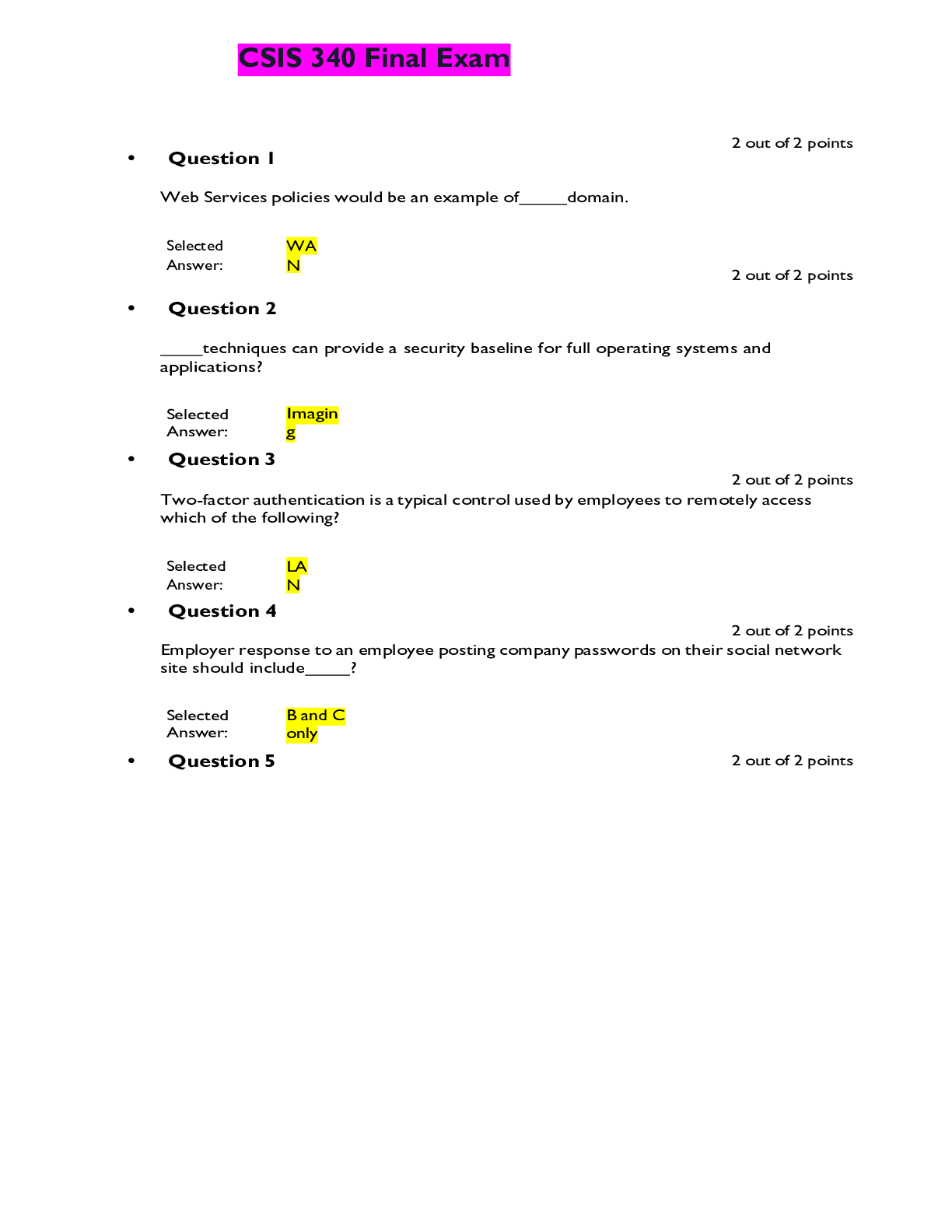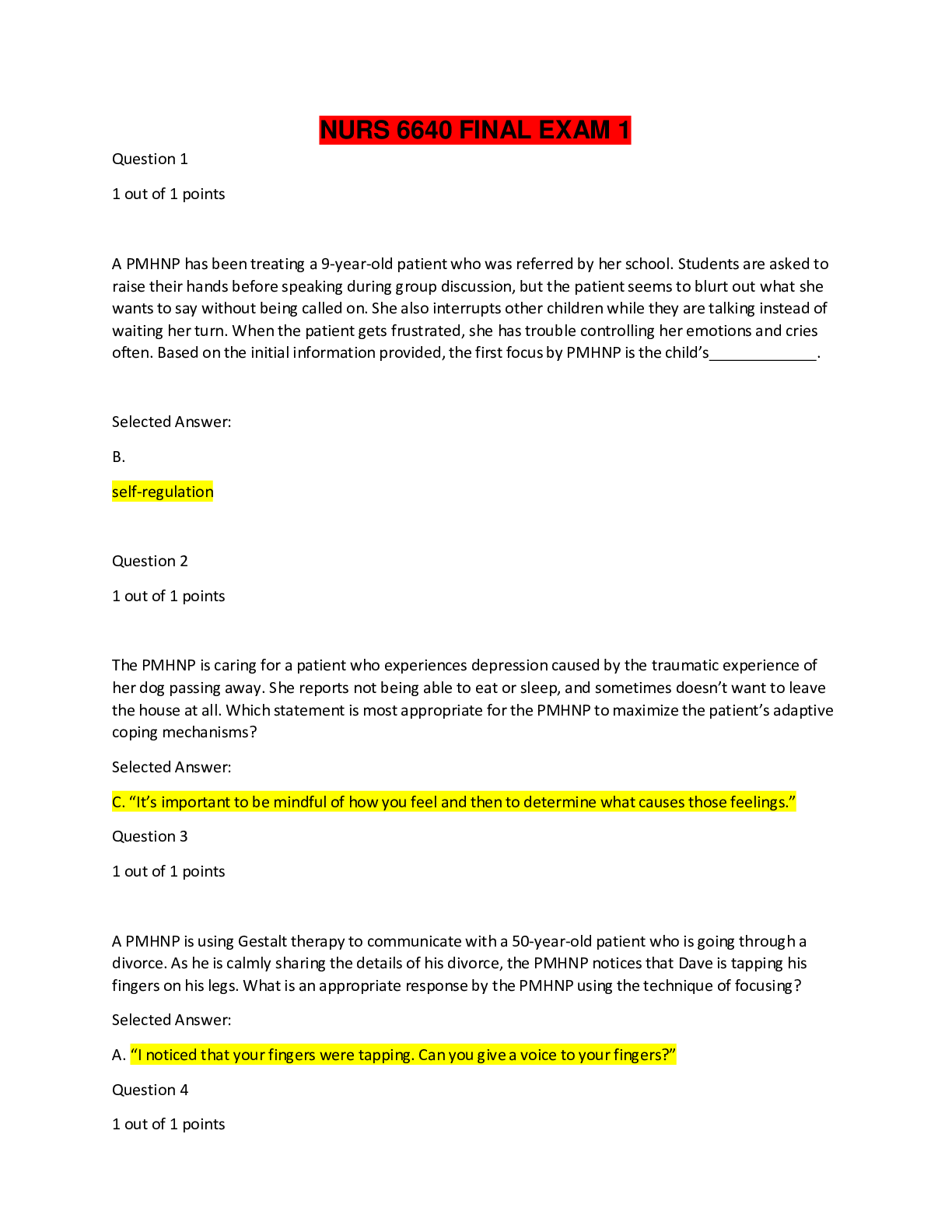*NURSING > EXAM > Certified Neuroscience Nurse Review 54 Questions with Verified Answers,100% CORRECT (All)
Certified Neuroscience Nurse Review 54 Questions with Verified Answers,100% CORRECT
Document Content and Description Below
Certified Neuroscience Nurse Review 54 Questions with Verified Answers Key characteristics of the frontal lobe? - CORRECT ANSWER -Emotions & Personality *-Motor Function, Broca's area (language... production* -Social and Sexual behaviors (initiation, judgement, impulse control, problem solving) -Memory What type of aphasia does damage to the broca's area cause? - CORRECT ANSWER *Expressive Aphasia* Damage to the broca causes the inability to perform the motor aspects of speech Key characteristics of the temporal lobe? - CORRECT ANSWER -Auditory ability -Long term memory -Wernicke's Area Damage to what lobe (and laterality of the lobe) will cause Wernicke's aphasia? - CORRECT ANSWER Temporal Lobe (Left in 90% of the population) What is Wernicke's aphasia? - CORRECT ANSWER Receptive aphasia due to damage to the temporal lobe (primarily left). Interprets the meaning of spoken/written word (processing issue) How does broca's aphasia present? - CORRECT ANSWER Patient can understand you but cannot form words. They follow verbal commands and appropriate execute requests, but they cannot verbally construct their words. How does wernicke's aphasia present? - CORRECT ANSWER The patient CAN form normal words, but when they do it is incoherent and inappropriate. They do not follow verbal commands but may follow if the command is demonstrated. The reason for this is because they cannot process language. Key characteristics of the parietal lobe? - CORRECT ANSWER -Visual-Spatial information/orientation -Sensory interpretation -Voluntary movements (goal directed) -Object manipulation Definition of dysphonia? - CORRECT ANSWER -Inability to speak secondary to laryngeal damage/paralysis (laryngeal inflammation, thickening of the vocal cords, or nerve paralysis) Definition of dysarthria? - CORRECT ANSWER -Inability to articulate words (slurred speech) Definition of aphasia? - CORRECT ANSWER -When damage to the language centers of the brain occur BUT the motor speech muscles (on face) are intact What is global aphasia? - CORRECT ANSWER When there is damage to the expressive (broca) and receptive (wernicke) areas of the brain Key characteristics of the occipital lobe? - CORRECT ANSWER -Primary Visual Cortex (visual input processing) -Secondary Visual Cortex (interprets meaning of written word) -Optic tract end point Where is the primary visual cortex? What does it do? - CORRECT ANSWER The Occipital lobe It processes primary visual input such as objects, colors, etc Where is the secondary visual cortex? What does it do? - CORRECT ANSWER The Occipital lobe It interprets the meaning of written words Key characteristics of the cerebellum? - CORRECT ANSWER -Coordination of voluntary movements -Balance and equilibrium Key characteristics of the brainstem? - CORRECT ANSWER *BASICS OF LIFE* -Breathing -Heart rate -Autonomic nervous system Components of the brain stem? (3) - CORRECT ANSWER Midbrain, Pons, Medulla Oblongata Key functions of the midbrain? - CORRECT ANSWER -CN-III & CN-IV function -Eye/trunk movement in response to visual input (reaction time) Key function of the Pons? - CORRECT ANSWER -CN-V through CN-VIII Function -Awakening & Respiratory center Key functions of the medulla oblongata? - CORRECT ANSWER -CN-IX through CN-XII functions -Autonomic functions -Relays information between somatic system and brain What is the definition of brain death? - CORRECT ANSWER Loss of all brain and brainstem function *spinal reflexes may stay intact* What is the gold standard for determining brain death? - CORRECT ANSWER Cerebral flood flow exam What are the common brain death testing tests? - CORRECT ANSWER -Cerebral Blood Flow -Doll's eyes -Cold caloric testing -Apnea Test What is the occulocephalic reflex? - CORRECT ANSWER -"dolls eyes" reflex -Open eye lids and turn head from side to side. The normal response is that the eyes fixate and do not move with head. ABNORMAL = Eyes follow the direction of the head What is the corpus callosum? - CORRECT ANSWER The single pathway of nerves that connect hte left and right hemispheres of the brain. It is a thick band of nervous fibers that facilitates the communication and transfers motor, sensory, and cognitive information What is the Basal Ganglia? - CORRECT ANSWER -It is the link between the thalamus and motor cortex -It coordinates muscle contractions related to posture and is part of the extrapyramidal system that regulates autonomic movement and suppressing unwanted movements. Where is the extrapyramidal system located? - CORRECT ANSWER The basal ganglia Functions of the limbic system? - CORRECT ANSWER -Primitive behaviors (sex, rage, fear, biological rhythms) -Emotional control -Filters extraneous stimuli Structures inside of the diencephalon? (3) - CORRECT ANSWER Thalamus, Hypothalamus, Pituitary Gland Key function of the thalamus? - CORRECT ANSWER Relay center for major nerve tracts Key functions of the hypothalamus? - CORRECT ANSWER -Eating/Hunger -Hormone regulation Key functions of the pituitary gland? - CORRECT ANSWER -Hormonal regulation Components of the GCS? - CORRECT ANSWER -Eye Opening _Verbal Response -Motor Response Eye Opening Response GCS? - CORRECT ANSWER 4) Spontaneous 3) To voice 2) To pain 1) None Verbal Response GCS? - CORRECT ANSWER 5) Alert and oriented 4) Confused 3) Incomprehensible words 2) Incomprehensible sounds (no words) 1) None Motor Response GCS? - CORRECT ANSWER 6) Normal 5) Location to pain 4) Withdraws to pain 3) Decorticate posturing (to core) 2) Decerebrate posturing (extension) What is the most sensitive indicator of change in neurological status in an baseline intact patient? - CORRECT ANSWER Level of consciousness What are some causes of pinpoint pupils? - CORRECT ANSWER -Narcotics -Pon issues Cranial Nerve 1 - CORRECT ANSWER Olfactory (sensory) -Sense of smell Test by having patient smell distinctive smells Cranial Nerve 2 - CORRECT ANSWER Optic (sensory) -Controls central and peripheral -Test by having patient read Cranial Nerve 3 - CORRECT ANSWER Oculomotor (motor) -Pupillary response -Test via cardinal fields (upwards) Cranial Nerve 4 - CORRECT ANSWER Trochlear (motor) -Moves eyes towards tip of nose -Test via cardinal fields (nose) Cranial Nerve 5 - CORRECT ANSWER Trigeminal (both) +Three Deviations of Nerve+ -V1; Ophthalmic -V2; Maxillary -V3; Mandibular -Test by having patient chew (mastication) AND facial sensation on forehead, maxilla, and mandible Cranial Nerve 6 - CORRECT ANSWER Abducens (motor) -Innervates the lateral rectus (Lateral movement of eyes) -Test by having patient move their eyes from ear to ear (Horizontal field of gaze) Cranial Nerve 7 - CORRECT ANSWER Facial Nerve (both) -Motor to facial muscles for expression -Sensory of anterior 2/3rds of tongue -Test by having patient wrinkle forehead, raise eyebrows, close eyes tightly shut, show teeth, and puff out cheeks Cranial Nerve 8 - CORRECT ANSWER Vestibulocochlear (sensory) -Sensory for hearing. -Test by rubbing fingers together by patients ear Cranial Nerve 9 - CORRECT ANSWER Glossopharyngeal (both) -Sensory to the posterior 2/3rds of the tongue, larynx an pharynx to mediate the *gag reflex* -Motor to uvula -Test by having patient say "ahh" while watching for uvula rise. Cranial Nerve 10 - CORRECT ANSWER Vagus (both) -Branches from the vagus innervate organs and structures throughout the body and have both motor and sensory functions (vagal down) -Test by having patient cough Cranial Nerve 11 - CORRECT ANSWER Spinal "Accessory" Nerve (motor) -Motor movement of the neck and shoulders -Test by having patient shrug their shoulders and turn their head from side to side Cranial Nerve 12 - CORRECT ANSWER Hypoglossal Nerve (motor) -Movement of the tongue -Test by having patient stick out their tongue -Left dysfunction will cause left deviation -Right dysfunction will cause right deviation Definition of antalgic? - CORRECT ANSWER A gait movement characterized by side-to-side jerkiness with decreased hip rotation and pain while walking -Primary cause is arthritis of the hip joint Definition of hemiparetic? - CORRECT ANSWER A gait movement characterized by the paralysis of one side of the body and is characterized by dragging of the paralyzed leg and flexion of the elbow and wrist Definition of ataxia? - CORRECT ANSWER Imbalanced movement that is most commonly seen with alcoholic intoxication [Show More]
Last updated: 8 months ago
Preview 1 out of 8 pages
Instant download
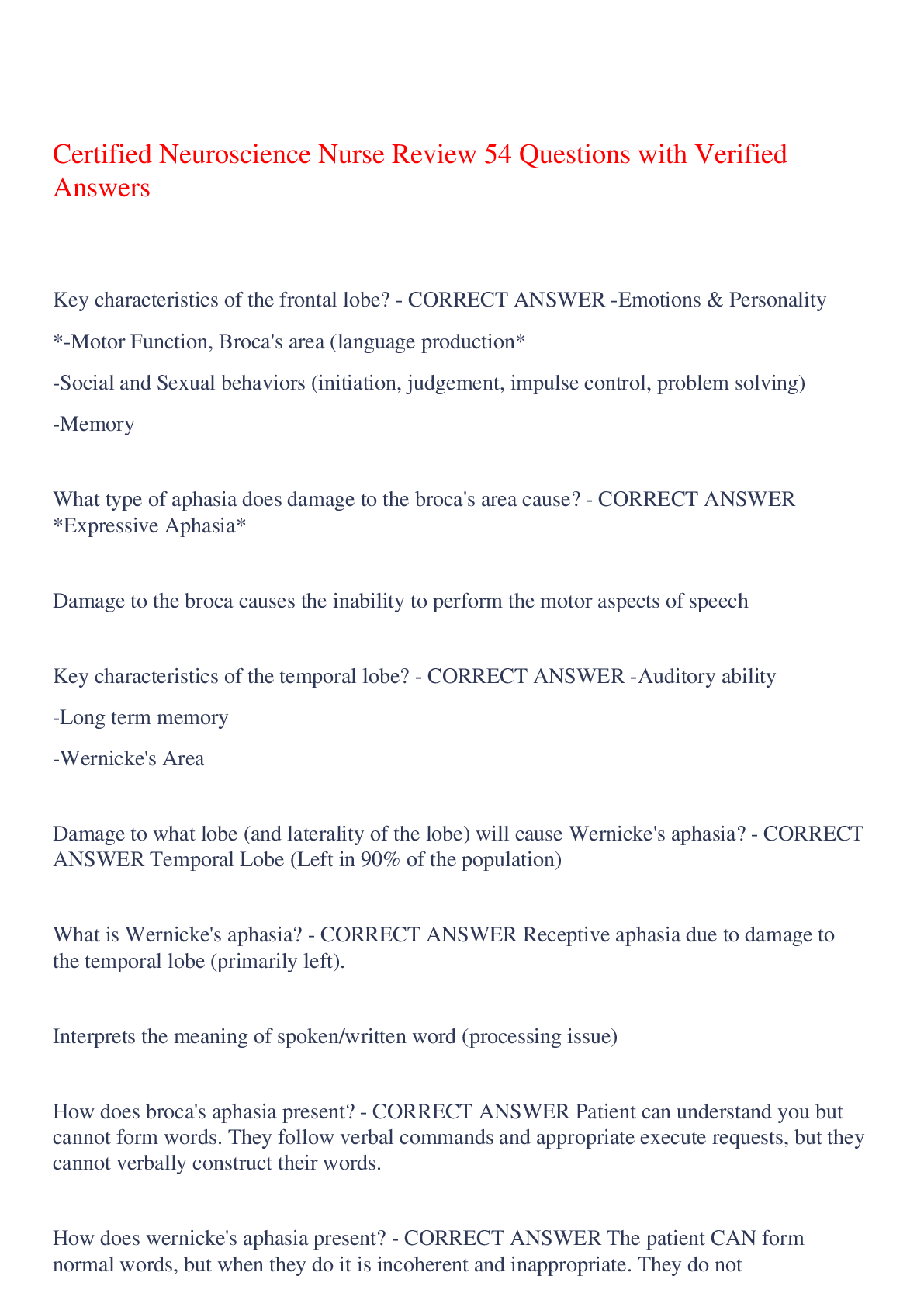
Buy this document to get the full access instantly
Instant Download Access after purchase
Add to cartInstant download
Reviews( 0 )
Document information
Connected school, study & course
About the document
Uploaded On
Oct 24, 2023
Number of pages
8
Written in
Additional information
This document has been written for:
Uploaded
Oct 24, 2023
Downloads
0
Views
68














